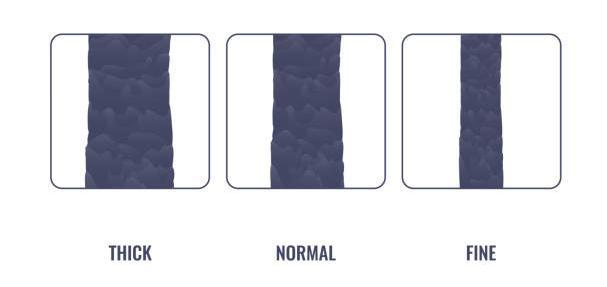Hair textures can be understood from different aspects—how the hair feels, the curl pattern, the strength, the intensity, the density, the state of your curls, the shape your hair and so on. Each of us is endowed with a specific kind of hair textures which might do or not be changed during the lifetime and you are always learning about how to get along well with your natural hair types, no matter what your hair is.

People tend to distinguish hair types and hair texture from two certain realms in general. Hair texture type are usually limited to describe the thickness of your individual hair strands and it can be classified as fine or medium hair, and thick or coarse hair while hair types are used to categorize the hair shape.
Hair types include straight, wavy hair, curly hair and coily hair. Knowing your hair types and hair texture is conducive to setting steps for hair care routine and promote hair growth.
To identify your hair texture, you can compare a piece of your hair strand to a thread.
- If your hair piece is thinner than the thread, then you have fine hair.
- If your hair piece is thicker than the thread, then you have coarse/thick hair.
- If the diameter of your hair strand is the same as the thread, then it is medium hair.
Fine Hair
The characteristics of fine hair:
-
This type of hair hair looks thin and can not hold styles well
-
This hair is fragile and prone to get oily and breakage.
-
Lack of volume
-
Will be weighed down by heavy products
Fine hair texture is typically the most soft and fragile hair texture with each strand of hair composed of only two hair layers—cortex and cuticle. Fine or thin hair group tend to have more hair pieces than thick hair strands because they are thinner but have more volume.
It might be difficult for thin hair type to hold all the hair in a style in that fall flat against your head and it is easy for fine texture to get oily in that fine hair will be more silk and sleek. Too heavy products might weigh down the light hair and the fine texture is prone to breakage as well.
Medium hair
The characteristics of medium hair
- Holds styles fairly well comparing with fine hair
- They look thicker and cover the head well
- Less prone to breakage like fine hair
Medium hair texture is the most common hair texture that most people have. It is thicker than fine hair with a cortex and cuticle or might have the third layer known as medulla. The extra layer medulla enable medium textures withstanding higher-stress styling or coloring.
The medium texture is less prone to break but more prone to dry. Medium hair can hold your hairstyles well and this type of hair can cover your scalp well with thicker volume.

Thick hair/coarse hair
The characteristics of thick/coarse texture
-
High volume with full head covering hair
-
Thick strands for complete hair layers—cortex, medulla, and cuticle
-
Strong tolerance to heat and damage
This kind of hair texture appears to be a full head of hair with total three hair layers—cortex, cuticle, and medulla. It is a high volume hair texture that can tolerate heat and resist breakage best.
The diameter of thick hair texture is the most wide among the all three hair textures and this feature make the hair moisture more prone to evaporate and the ends are easily to get dry. The individual hairs can be straight or curly shape.
Thick textured hair can be still resilient when it is heat, styled and chemically broken. It takes considerably longer to make your strands dry and coarse hair texture is prone to become dry and frizz,especially in humid weather. To care the thick textured hair, it is recommended to choose moisturizing products and hair products that can tame frizz.
How Curls are Created
Every strand of hair composed of keratin, a tough fibrous protein, grows from the follicle. The sulphur atoms in protein molecules pair up and form disulphide bond and the disulphide and hydrogen bonds hold the protein structures.
The distance between the sulphur atoms and the angle or the shape of follicle determine how straight or curly your hair is. The further distance are the sulphur atoms, the more bent are the protein molecules and the curlier is your hair.

The quantity and the place of disulphide bonds, the angle of follicle will affect the curl shape as well. The more angled is the follicle, the kinkier is your curl strand. The more disulphide bonds are in the hair shaft, the curlier is your hair. The less disulphide bonds are in the hair shaft, the more straight is your hair.
The disulphide bonds in straight hair are evenly distributed all over the hair shaft. The angled follicle is the one of the reasons why coily and kinky hair is more drier than straight hair because the natural oils are difficult to travel down to the ends of your hair shaft and the straight hair is on the contrary .

Disulphide bonds are kind of permanent bonds, or covalent bonds which are more easy to form and break. Both of the disulphide bonds and hydrogen bonds will change your hair.
When your are styling your curls, the hydrogen bonds or disulphide bonds are changed by the various chemical treatments, and your strands performed as relaxed, waved or curled, but as new hair grows, the natural hair structure recovers and your curls go back to its natural state.
How to take care of different hair texture types?
If your hair texture is fine, products with heavy moisturizers and long length hair should be avoid because they will weigh hair down and flatten it. The excessive oil will make your scalp greasy as well. Short haircuts, daily shampoo and conditioner are the solution to your hair texture. Cleaning the accumulated dirt, dust, oil and grime can keep your scalp healthy and grant bounce and shine to finer hair.
If your hair is medium and straight, then lightweight products that will smooth and tame your mane without weighing it down; if it is medium and curl type, then you can choose light heavier cream or serum. They can control the frizz and breakage which enable your hair to hold curls and styles. Antioxidant ingredients can clean your scalp and restore natural shine by removing impurities. Apply some products that can reduce frizz at the mid-lengths as well as the ends to prevent limpness.
As for the coarse texture, the hair tends to be difficult to style and becomes dry easily. Frequent washing will be unhealthy. Regular shampoo and condition can keep your hair and scalp clean and hydrated. If you have hair chemically processing or frequent heat styling, it is recommended to take repair treatments every month.
If your curl pattern is wavy hair, curly hair or coily hair with slight curve, beachy waves or tight coils, your curl definition tend to have a great deal of volume and bounce, and you may find your densely packed hair is fragile and prone to breakage no matter fine medium and coarse texture. This is due to natural hair’s porous structure. The very tight curls have weaker points where the curl bends. To keep the tightly coiled strands nourished and strong, extra moisture such as hair masks should be complemented in your styling products or leave in treatments.
Why hair texture changes
Ageing

When people growing old,the hair will also get into the aging process. Many people choose hair coloring to cover the process but it still happens. The natural hair become grey when it lost melanin and accumulate hydrogen peroxide, then your hair become thicker and wirier, called coarse.
The collagen production decrease and the natural oils from your hair tends to reduce. The dry hair textures need be well-hydrated and well-moisturized at that time to keep fine medium or coarse hair type in good condition.
Health condition and medicine

If your texture changes at short period, then you could take the health problem into consideration. If you have certain health problem but the texture changes newly, then you can record the time and what kind of medicine you are taking.
You can take some supplements or vitamins as a solution. If you do not like the new changes or lost hair in the curing process, wearing hair extensions or wigs is a great way to transform your look while waitingfor your natural hair to when your new hair haven't grow back.
Over-processing

Another factor affecting your curly hair type is over-processing. Chemical relaxers, unnecessary hair care or heat treatment all have an impact on hair type. The natural integrity is changed the damage is done, and the texture is turned. Coloring, relaxing, perming, and heating with blow dryer or flat iron lead to dry, brittle, rough strands. To regain defined curls, you can do a big chop to allow new growth.
Hormonal Change

Hormones change with age gradually, but when you are pregnant, it will be stimulated to increase in short time. You might have thick and shiny locs because hormones accelerate the hair growth and reduce hair loss. The texture type might change as well.
In choosing hair extensions that perfectly blend with your hair type, check out this blog:The Complete Guide & Caring Tips For 3A Hair
(*Unsure about which texture to choose for blending, feel free to email our CSR (support@curlsqueen.com) with photos of your natural hair. We will provide you with our recommendations.)






